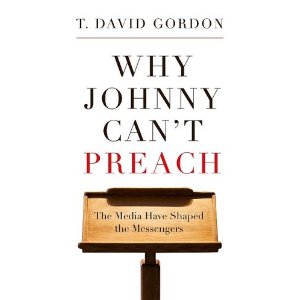 On Wednesday I mentioned R.L. Dabney’s seven “cardinal requisites for the sermon”: textual fidelity, unity, evangelical tone, instructiveness, movement, pointedness, and order.
On Wednesday I mentioned R.L. Dabney’s seven “cardinal requisites for the sermon”: textual fidelity, unity, evangelical tone, instructiveness, movement, pointedness, and order.
Lo and behold, the next day I decided to reread T. David Gordon’s Why Johnny Can’t Preach and found the first chapter is largely occupied with comments on the seven requisites. Gordon is especially useful in providing the following test questions for each of Dabney’s requirements:
- Textual Fidelity. Does the significant point of the sermon arise out of the significant point of the text? Is the thrust of the sermon merely an aside in the text? Is the text merely a pretext for the minister’s own idea?
- Unity. If ten people are asked after the sermon what the sermon was about, will at least eight of them give the same (or a similar) answer?
- Evangelical Tone. Do the hearers get the impression that the minister is for them (eager to see them richly blessed by a gracious God), or against them (eager to put them in their place, scold them, reprimand them, or punish them)? Is it his desire to see them reconciled to and blessed by a pardoning God? Does the sermon press the hearer to consider the hopelessness of his condition apart from Christ, and the utter competence of Christ to rescue the penitent sinner?
- Intructiveness. Does the sermon significantly engage the mind, or is the sermon full of commonplace cliches, slogans, and general truths? Is the hearer genuinely likely to rethink his view of God, society, church, or self, or his reasons for holding his current views? Is the mind of the attentive listener engaged or repulsed?
- Movement. Do the earlier parts of the sermon contribute to the latter parts’ full effect? Does the sermon have intellectual (and consequently emotional) momentum?
- Pointedness. Is the effect of the sermon, on those who believe it, similar? If it encouraged one, did it tend to encourage all, and for the same reason? If it troubled one, did it trouble all, and for the same reason? If it made one thankful, did it ten to make all thankful, and for the same reason?
- Order. Could the hearers compare notes and reproduce the outline of the sermon? If they could not reproduce the outline, could they state how it progressed from one part to another?
Preachers around the world today will ascend to the sacred desk to offer sacred rhetoric from the Sacred Book. May they do so with faithfulness to all these “requisites.”
